Space Electroosmotic Thrusters in Ion Partitioning Soft Nanochannels
Abstract
:1. Introduction
2. Mathematical Model Analysis
2.1. Electric Potential
2.2. Fluid Velocity
3. Thruster Performance Analysis
3.1. Specific Impulse
3.2. Thrust
3.3. Efficiency
3.4. Thrust-to-Power Ratio
4. Results and Discussion
5. Conclusions
Author Contributions
Funding
Institutional Review Board Statement
Informed Consent Statement
Data Availability Statement
Acknowledgments
Conflicts of Interest
Appendix A. Dimensionless Expressions of the EOT Energy
References
- Groot, W.D. Propulsion options for primary thrust and attitude control of microspacecraft. COSPAR Colloq. Ser. 1999, 10, 200–209. [Google Scholar]
- Wright, W.; Ferrer, P. Electric micropropulsion systems. Prog. Aerosp. Sci. 2015, 74, 48–61. [Google Scholar] [CrossRef]
- Takahashi, T.; Takao, Y.; Eriguchi, K.; Ono, K. Microwave-excited microplasma thruster: A numerical and experimental study of the plasma generation and micronozzle flow. J. Phys. D Appl. Phys. 2008, 41, 194005. [Google Scholar] [CrossRef]
- Ahmad, M.R.; Jamil, Y.; Saeed, H.; Hussain, T. A new perspective of ablative pulsed laser propulsion: Study on different morphologies of nano-structured ZnO. Laser Phys. Lett. 2015, 12, 56101. [Google Scholar] [CrossRef]
- Blanco, A.; Roy, S. Rarefied gas electro jet (RGEJ) micro-thruster for space propulsion. J. Phys. D Appl. Phys. 2017, 50, 455201. [Google Scholar] [CrossRef] [Green Version]
- Ferreira, J.L.; Martins, A.A.; Miranda, R.; Porto, M.C.F.; Coelho, H.O. Hall plasma thruster development for micro and nano satellites. J. Phys. Conf. Ser. 2019, 1365, 012026. [Google Scholar] [CrossRef]
- Martinez-Sanchez, M.; Pollard, J.E. Spacecraft Electric Propulsion—An Overview. J. Propuls. Power 1998, 14, 688–699. [Google Scholar] [CrossRef] [Green Version]
- Keidar, M.; Zhuang, T.; Shashurin, A.; Teel, G.; Chiu, D.; Lukas, J.; Haque, S.; Brieda, L. Electric propulsion for small satellites. Plasma Phys. Control. Fusion 2014, 57, 014005. [Google Scholar] [CrossRef]
- Chen, C.-H.; Santiago, J.G. A planar electroosmotic micropump. J. Microelectromech. Syst. 2002, 11, 672–683. [Google Scholar] [CrossRef] [Green Version]
- Patel, K.D.; Bartsch, M.; McCrink, M.H.; Olsen, J.S.; Mosier, B.P.; Crocker, R.W. Electrokinetic pumping of liquid propellants for small satellite microthruster applications. Sens. Actuators B Chem. 2008, 132, 461–470. [Google Scholar] [CrossRef]
- Nagai, M.; Kato, K.; Soga, S.; Santra, T.S.; Shibata, T. Scalable Parallel Manipulation of Single Cells Using Micronozzle Array Integrated with Bidirectional Electrokinetic Pumps. Micromachines 2020, 11, 442. [Google Scholar] [CrossRef] [PubMed]
- Masliyah, J.H.; Bhattacharjee, S. Electrokinetic and Colloid Transport. Phenomena; Wiley-Interscience: Hoboken, NJ, USA, 2006; pp. 537–611. [Google Scholar]
- Ji, J.; Qian, S.; Liu, Z. Electroosmotic Flow of Viscoelastic Fluid through a Constriction Microchannel. Micromachines 2021, 12, 417. [Google Scholar] [CrossRef] [PubMed]
- Deng, S.; Zeng, Y.; Li, M.; Liang, C. Electroosmotic Flow of Non-Newtonian Fluid in Porous Polymer Membrane at High Zeta Potentials. Micromachines 2020, 11, 1046. [Google Scholar] [CrossRef] [PubMed]
- Casas, L.; Ortega, J.A.; Gómez, A.; Escandón, J.; Vargas, R.O. Analytical Solution of Mixed Electroosmotic/Pressure Driven Flow of Viscoelastic Fluids between a Parallel Flat Plates Micro-Channel: The Maxwell Model Using the Oldroyd and Jaumann Time Derivatives. Micromachines 2020, 11, 986. [Google Scholar] [CrossRef]
- Lim, A.; Lam, Y. Numerical Investigation of Nanostructure Orientation on Electroosmotic Flow. Micromachines 2020, 11, 971. [Google Scholar] [CrossRef]
- Diez, F.; Hernaiz, G.; Miranda, J.; Sureda, M. On the capabilities of nano electrokinetic thrusters for space propulsion. Acta Astronaut. 2013, 83, 97–107. [Google Scholar] [CrossRef]
- Huang, K.H.; Huang, H.F. Two-liquid electroosmotic thrusters for micro propulsion application. Phys. Fluids 2019, 31, 122003. [Google Scholar]
- Deng, L.; Shi, L.; Zhou, T.; Zhang, X.; Joo, S.W. Charge Properties and Electric Field Energy Density of Functional Group-Modified Nanoparticle Interacting with a Flat Substrate. Micromachines 2020, 11, 1038. [Google Scholar] [CrossRef]
- Ohshima, H. Theory of electrostatics and electrokinetics of soft particles. Sci. Technol. Adv. Mater. 2009, 10, 063001. [Google Scholar] [CrossRef]
- Ohshima, H. Electrical phenomena in a suspension of soft particles. Soft Matter 2012, 8, 3511–3514. [Google Scholar] [CrossRef]
- Konishi, S.; Mori, F.; Shimizu, A.; Hirata, A. Structural Reinforcement Effect of a Flexible Strain Sensor Integrated with Pneumatic Balloon Actuators for Soft Microrobot Fingers. Micromachines 2021, 12, 395. [Google Scholar] [CrossRef]
- Kimiko, M.; Hiroyuki, O. Soft particle analysis of electrokinetics of biological cells and their model systems. Sci. Technol. Adv. Mater. 2011, 12, 023001. [Google Scholar]
- Zheng, D.-C.; Yeh, L.-H. Improved Rectification and Osmotic Power in Polyelectrolyte-Filled Mesopores. Micromachines 2020, 11, 949. [Google Scholar] [CrossRef] [PubMed]
- Bartolo, D.; Aarts, D.G.A.L. Microfluidics and soft matter: Small is useful. Soft Matter 2012, 8, 10530–10535. [Google Scholar] [CrossRef]
- Hu, L.; Wu, H. Mathematical model of electro-osmotic consolidation for soft ground improvement. Géotechnique 2014, 64, 155–164. [Google Scholar] [CrossRef]
- Lorente, S. Constructal view of electrokinetic transfer through porous media. J. Phys. D Appl. Phys. 2007, 40, 2941–2947. [Google Scholar] [CrossRef]
- Keh, H.J.; Ding, J.M. Electrokinetic flow in a capillary with a charge-regulating surface polymer layer. J. Colloid Interface Sci. 2003, 263, 645–660. [Google Scholar] [CrossRef]
- Chanda, S.; Sinha, S.; Das, S. Streaming potential and electroviscous effects in soft nanochannels: Towards designing more efficient nanofluidic electrochemomechanical energy converters. Soft Matter 2014, 10, 7558–7568. [Google Scholar] [CrossRef]
- Balasubramanian, S.; Kaushik, P.; Mondal, P.K. Dynamics of viscoelastic fluid in a rotating soft microchannel. Phys. Fluids 2020, 32, 112003. [Google Scholar] [CrossRef]
- Matin, M.H.; Ohshima, H. Combined electroosmotically and pressure driven flow in soft nanofluidics. J. Colloid Interface Sci. 2015, 460, 361–369. [Google Scholar] [CrossRef]
- Zhao, G.; Jian, Y. Thermal transport of combined electroosmotically and pressure driven nanofluid flow in soft nanochannels. J. Therm. Anal. Calorim. 2018, 135, 379–391. [Google Scholar] [CrossRef]
- Wang, Z.; Jian, Y. Heat Transport of Electrokinetic Flow in Slit Soft Nanochannels. Micromachines 2019, 10, 34. [Google Scholar] [CrossRef] [PubMed] [Green Version]
- Benson, L.; Yeh, L.-H.; Chou, T.-H.; Qian, S. Field effect regulation of Donnan potential and electrokinetic flow in a functionalized soft nanochannel. Soft Matter 2013, 9, 9767. [Google Scholar] [CrossRef]
- Zheng, J.; Jian, Y. Electroosmotic thrusters in soft nanochannels for space propulsion. Phys. Fluids 2020, 32, 122005. [Google Scholar] [CrossRef]
- Poddar, A.; Maity, D.; Bandopadhyay, A.; Chakraborty, S. Electrokinetics in polyelectrolyte grafted nanofluidic channels modulated by the ion partitioning effect. Soft Matter 2016, 12, 5968–5978. [Google Scholar] [CrossRef] [PubMed]
- Ganjizade, A.; Sadeghi, A.; Ashrafizadeh, S.N. Effect of ion partitioning on electrostatics of soft particles with volumetrically charged inner core coated with pH-regulated polyelectrolyte layer. Colloids Surf. B Biointerfaces 2018, 170, 129–135. [Google Scholar] [CrossRef]
- Barbosa, N.S.V.; Lima, E.R.A.; Boström, M.; Tavares, F.W. Membrane Potential and Ion Partitioning in an Erythrocyte Using the Poisson–Boltzmann Equation. J. Phys. Chem. B 2015, 119, 6379–6388. [Google Scholar] [CrossRef]
- Reshadi, M.; Saidi, M.H. The role of ion partitioning in electrohydrodynamic characteristics of soft nanofluidics: Inclusion of EDL overlap and steric effects. Chem. Eng. Sci. 2018, 190, 443–458. [Google Scholar] [CrossRef]
- Idota, N.; Kikuchi, A.; Kobayashi, J.; Sakai, K.; Okano, T. Microfluidic Valves Comprising Nanolayered Thermoresponsive Polymer-Grafted Capillaries. Adv. Mater. 2005, 17, 2723–2727. [Google Scholar] [CrossRef]
- Dimitrov, D.I.; Milchev, A.; Binder, K. Local Viscosity in the Vicinity of a Wall Coated by Polymer Brush from Green-Kubo Relations. Macromol. Theory Simul. 2008, 17, 313–318. [Google Scholar] [CrossRef]
- Sadeghi, A.; Azari, M.; Hardt, S. Electroosmotic flow in soft microchannels at high grafting densities. Phys. Rev. Fluids 2019, 4, 063701. [Google Scholar] [CrossRef]
- Ganjizade, A.; Ashrafizadeh, S.N.; Sadeghi, A. Effect of ion partitioning on the electrostatics of soft particles with a volumetrically charged core. Electrochem. Commun. 2017, 84, 19–23. [Google Scholar] [CrossRef]
- Khatibi, M.; Ashrafizadeh, S.N.; Sadeghi, A. Covering the conical nanochannels with dense polyelectrolyte layers significantly improves the ionic current rectification. Anal. Chim. Acta 2020, 1122, 48–60. [Google Scholar] [CrossRef]
- Talebi, R.; Ashrafizadeh, S.N.; Sadeghi, A. Hydrodynamic dispersion by electroosmotic flow in soft microchannels: Consideration of different properties for electrolyte and polyelectrolyte layer. Chem. Eng. Sci. 2021, 229, 116058. [Google Scholar] [CrossRef]
- Kwak, S.H.; Kwon, S.-R.; Baek, S.; Lim, S.-M.; Joo, Y.-C.; Chung, T.D. Densely charged polyelectrolyte-stuffed nanochannel arrays for power generation from salinity gradient. Sci. Rep. 2016, 6, 26416. [Google Scholar] [CrossRef]
- Das, S.; Guha, A.; Mitra, S.K. Exploring new scaling regimes for streaming potential and electroviscous effects in a nanocapillary with overlapping Electric Double Layers. Anal. Chim. Acta 2013, 804, 159–166. [Google Scholar] [CrossRef]
- Das, S.; Chanda, S.; Eijkel, J.C.T.; Tas, N.R.; Chakraborty, S.; Mitra, S. Filling of charged cylindrical capillaries. Phys. Rev. E 2014, 90, 043011. [Google Scholar] [CrossRef] [Green Version]
- Sotres, J.; Baró, A. AFM Imaging and Analysis of Electrostatic Double Layer Forces on Single DNA Molecules. Biophys. J. 2010, 98, 1995–2004. [Google Scholar] [CrossRef] [PubMed] [Green Version]
- Choi, W.; Sharma, A.; Qian, S.; Lim, G.; Joo, S.W. On steady two-fluid electroosmotic flow with full interfacial electrostatics. J. Colloid Interface Sci. 2011, 357, 521–526. [Google Scholar] [CrossRef] [PubMed]
- Dukhin, S.S.; Zimmermann, R.; Duval, J.F.; Werner, C. On the applicability of the Brinkman equation in soft surface electrokinetics. J. Colloid Interface Sci. 2010, 350, 1–4. [Google Scholar] [CrossRef]
- Probstein, R.F. Physicochemical Hydrodynamics: An Introduction; Elsevier: Amsterdam, The Netherlands, 1994. [Google Scholar]
- Nguyen, N.T.; Wereley, S.T. Fundamentals and Applications of Microfluidics; Artech House: Fitchburg, MA, USA, 2002. [Google Scholar]
- Goebel, D.M.; Katz, I. Fundamentals of Electric Propulsion: Ion and Hall Thrusters; John Wiley & Sons: Hoboken, NJ, USA, 2008. [Google Scholar]
- Sutton, G.P.; Biblarz, O. Rocket Propulsion Elements; John Wiley & Sons: Hoboken, NJ, USA, 2001. [Google Scholar]
- Savatorova, V.; Rajagopal, K. Homogenization of a generalization of Brinkman’s equation for the flow of a fluid with pressure dependent viscosity through a rigid porous solid. ZAMM 2011, 91, 630–648. [Google Scholar] [CrossRef]
- Levine, S.; Marriott, J.; Neale, G.; Epstein, N. Theory of electrokinetic flow in fine cylindrical capillaries at high zeta-potentials. J. Colloid Interface Sci. 1975, 52, 136–149. [Google Scholar] [CrossRef]
- Yang, M.; Zhao, K. Influence of structure on the collapse of poly(N-isopropylacrylamide)-based microgels: An insight by quantitative dielectric analysis. Soft Matter 2016, 12, 4093–4102. [Google Scholar] [CrossRef]
- Yang, M.; Liu, C.; Lian, Y.; Zhao, K.; Zhu, D.; Zhou, J. Relaxations and phase transitions during the collapse of a dense PNIPAM microgel suspension—Thorough insight using dielectric spectroscopy. Soft Matter 2017, 13, 2663–2676. [Google Scholar] [CrossRef] [PubMed]
- Luo, J.; Chen, L.-S.; Duan, H.-Z.; Gong, Y.; Hu, S.; Ji, J.; Liu, Q.; Mei, J.; Milyukov, V.; Sazhin, M.; et al. TianQin: A space-borne gravitational wave detector. Class. Quantum Gravity 2016, 33, 035010. [Google Scholar] [CrossRef] [Green Version]

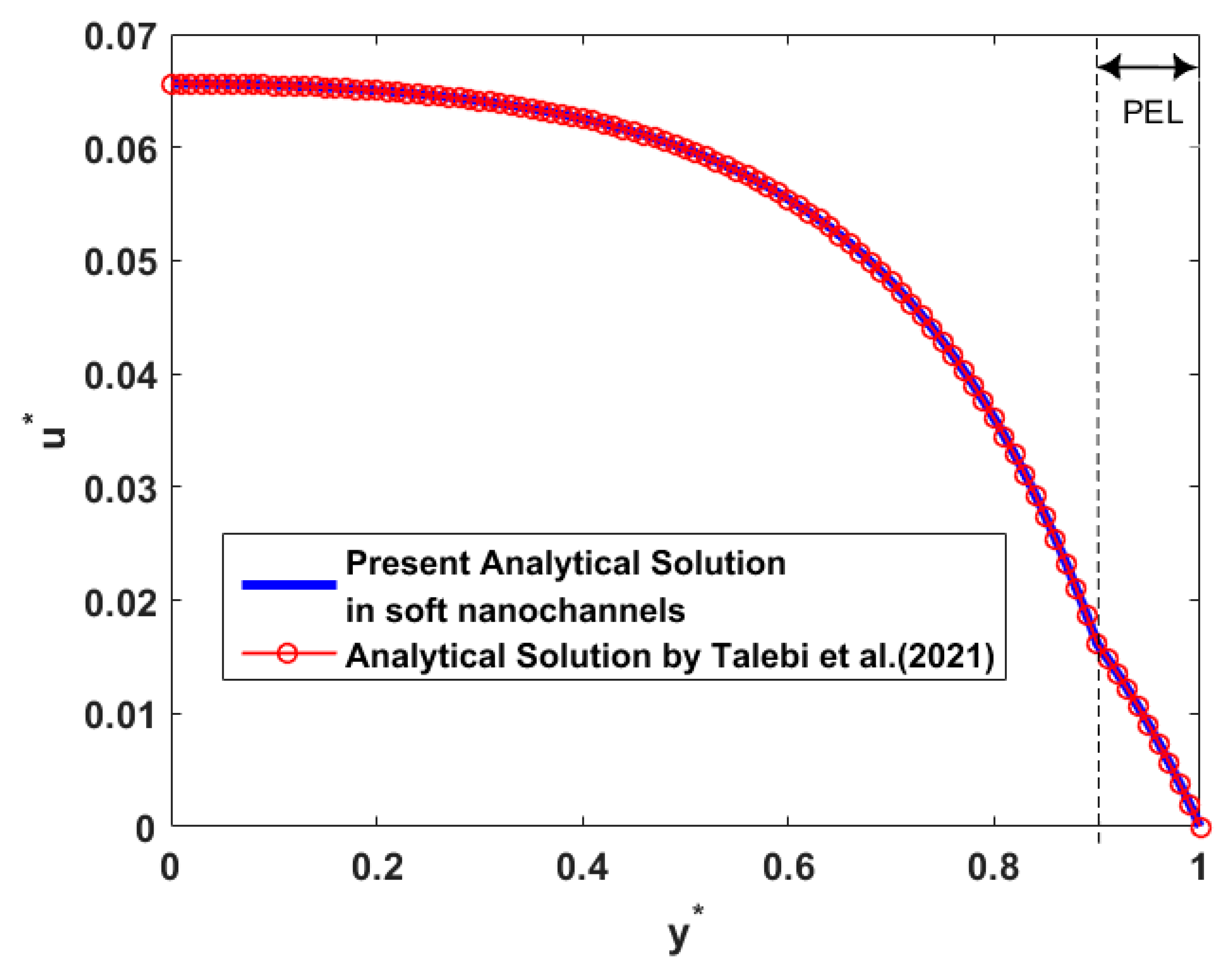
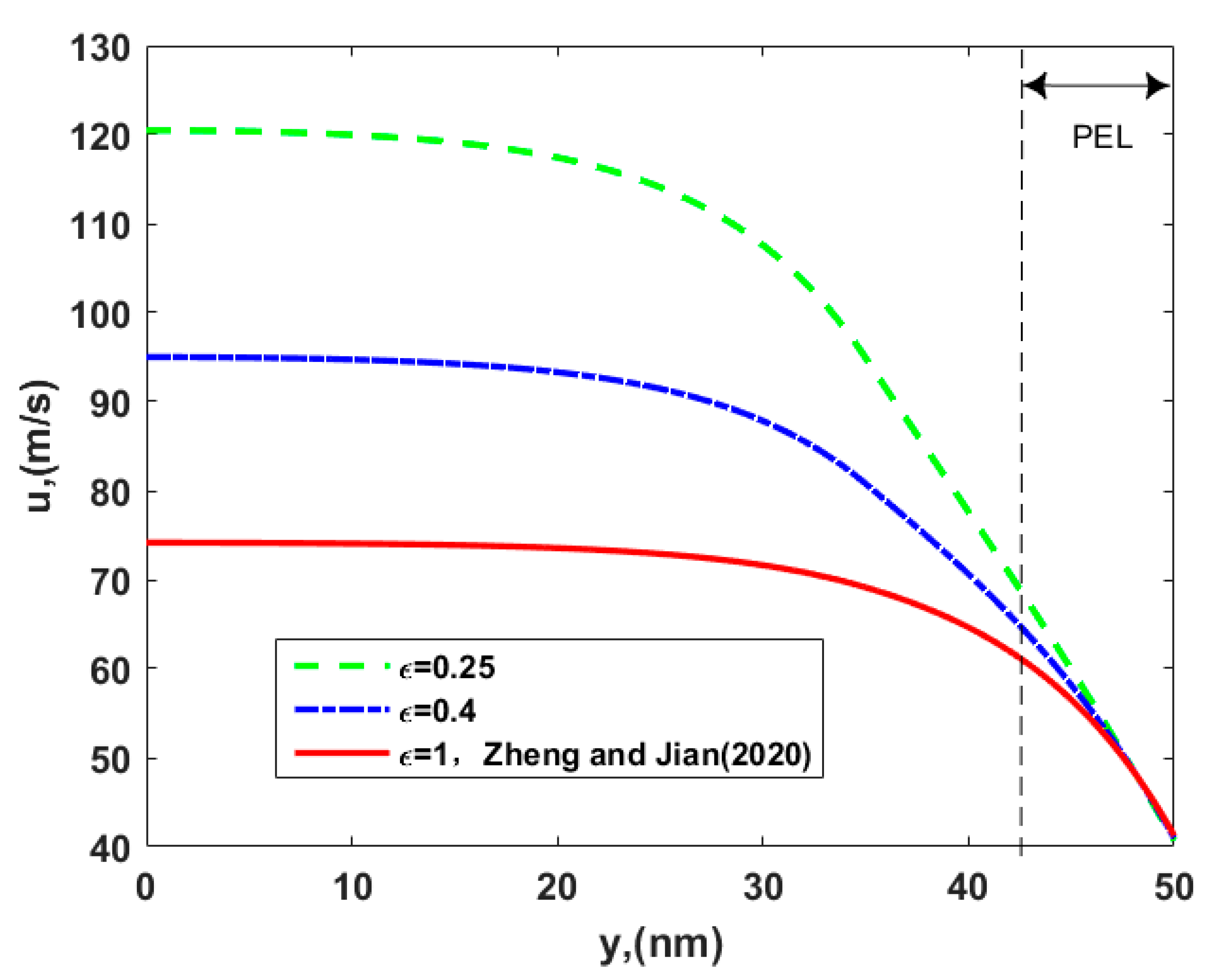
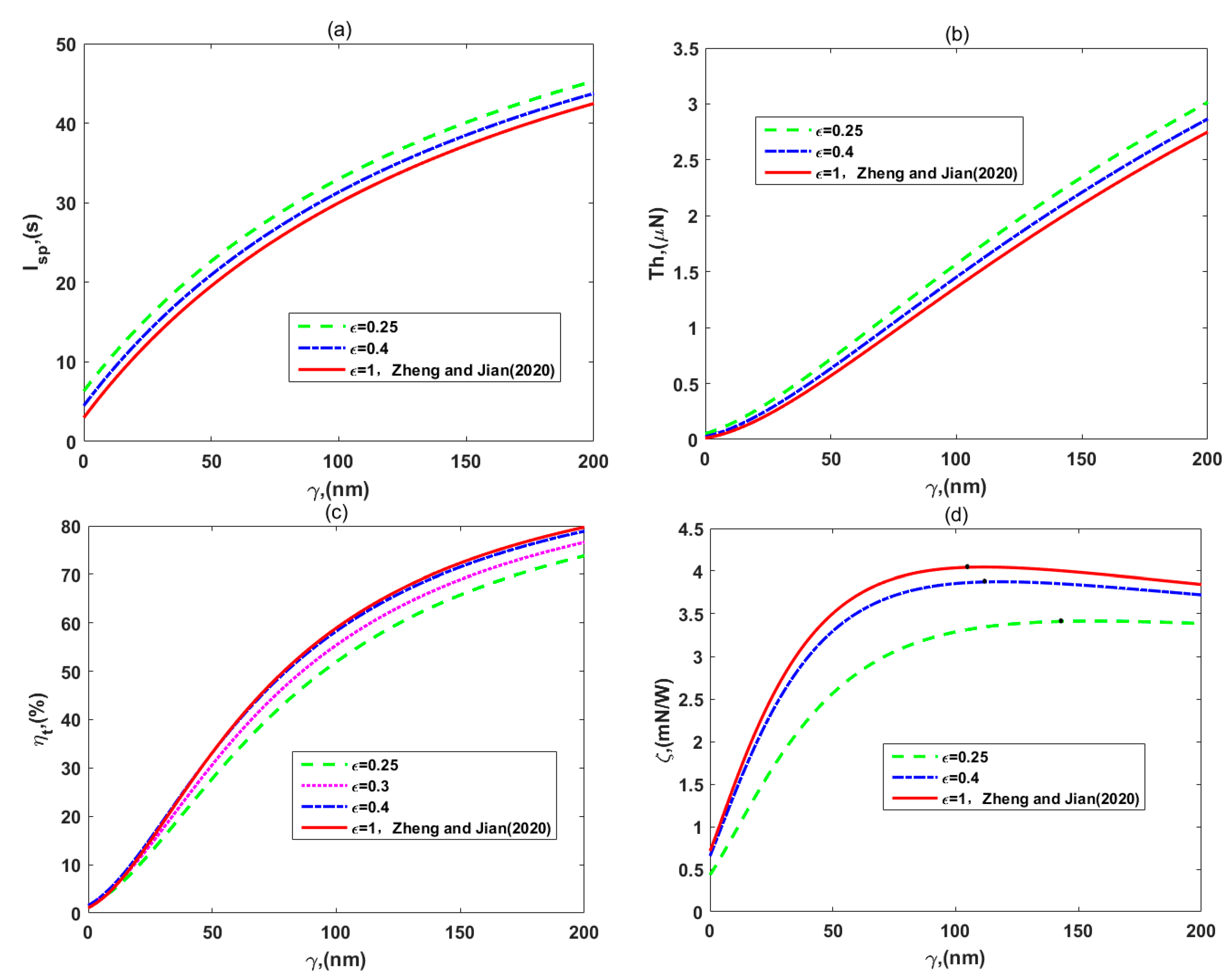
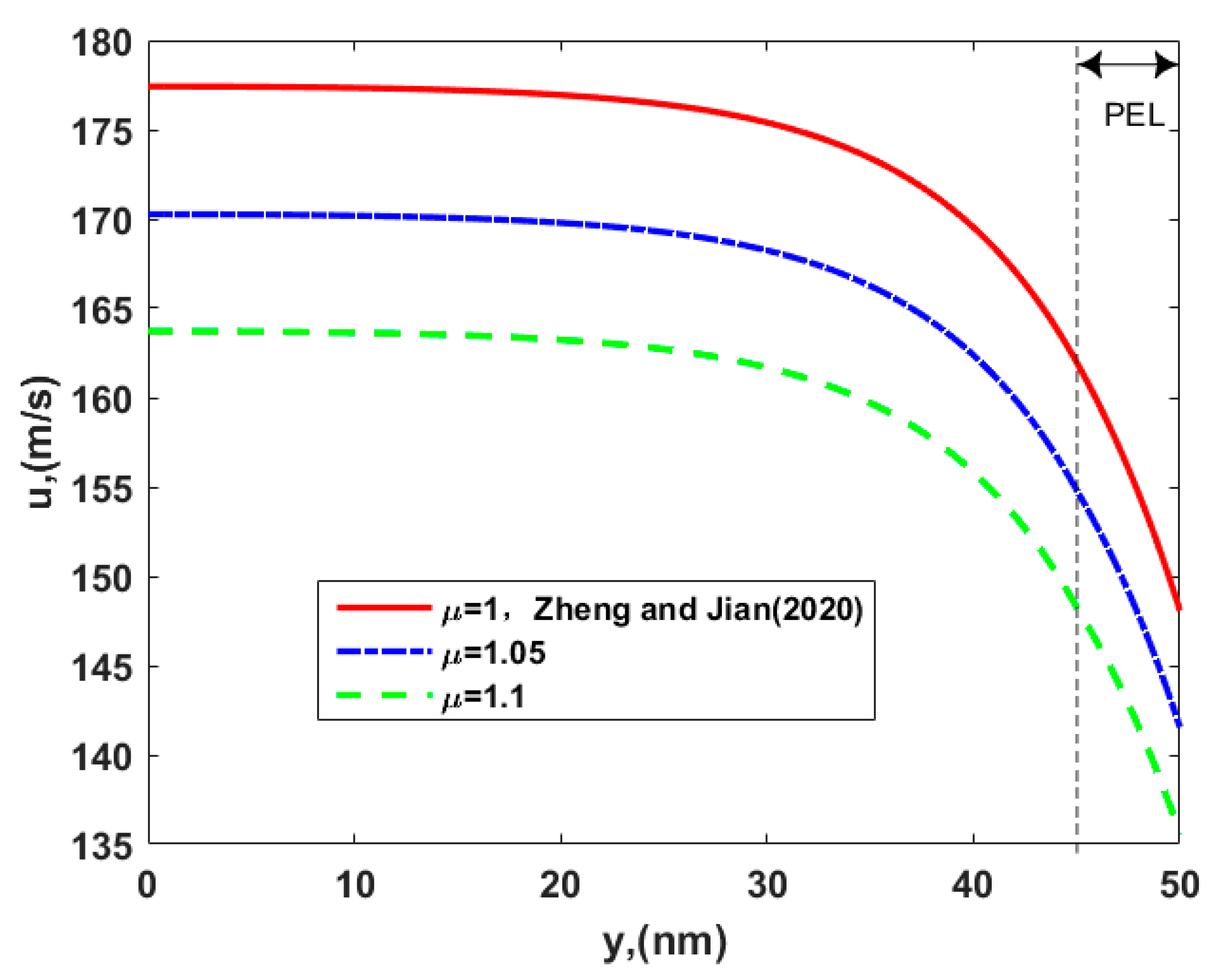
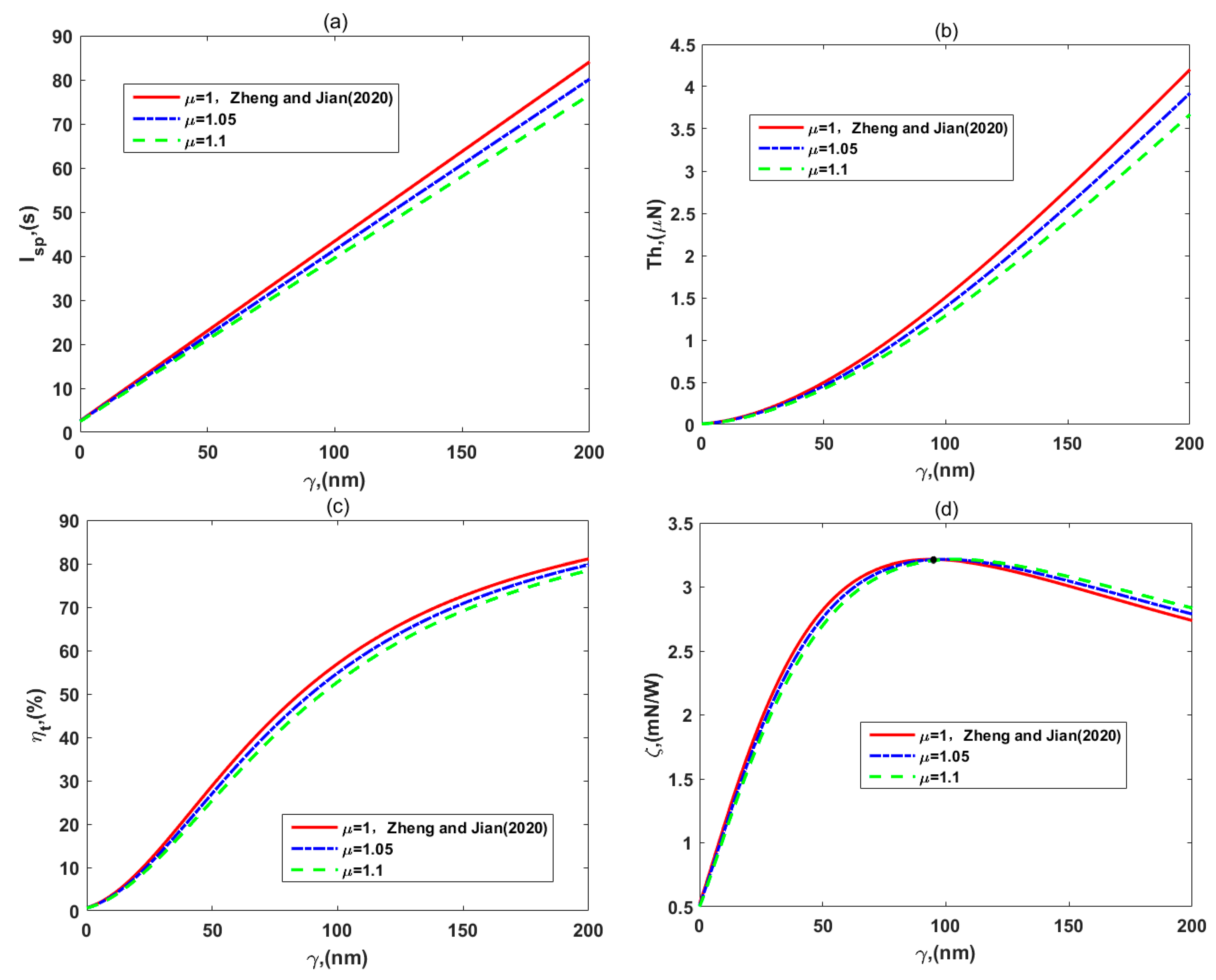
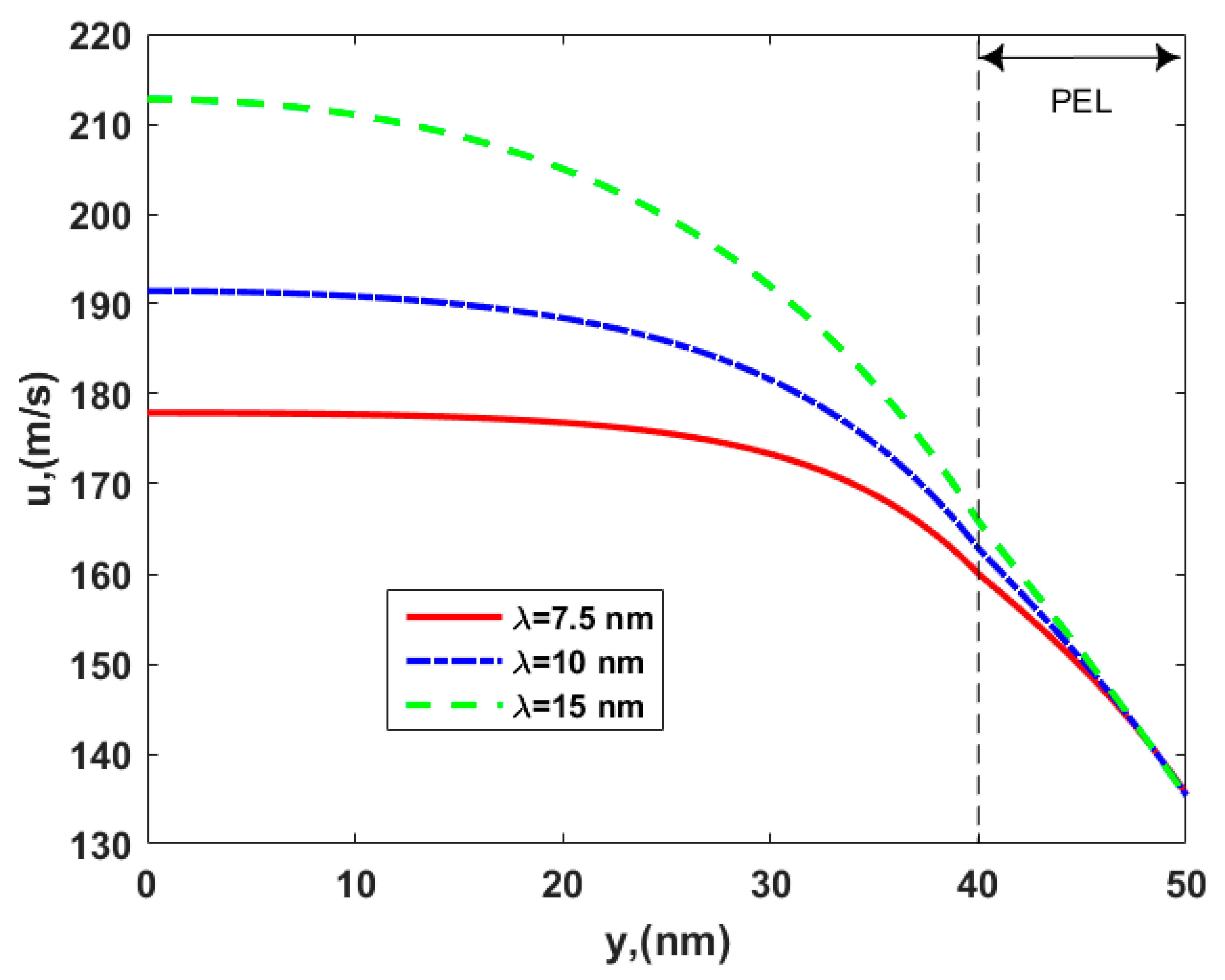
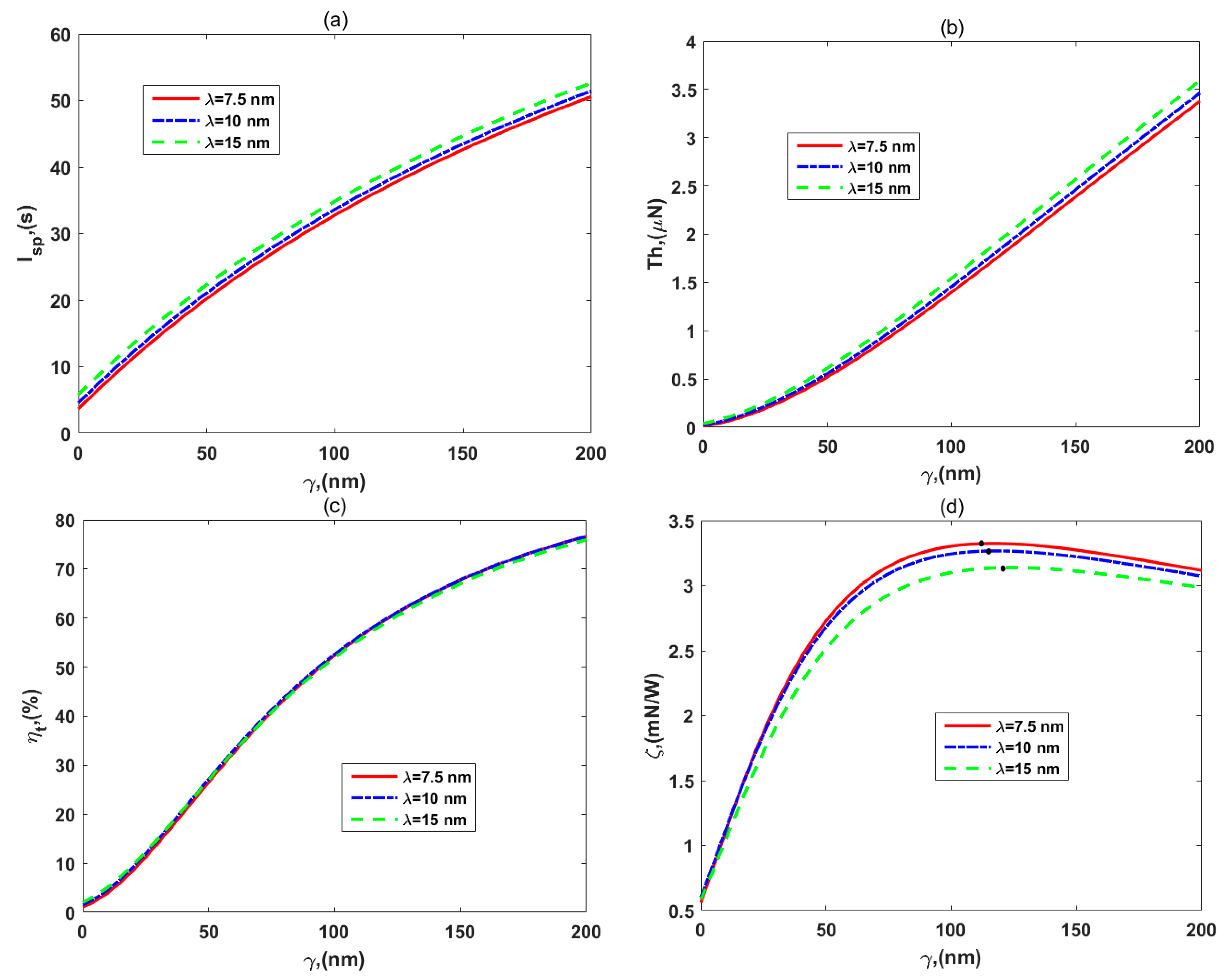
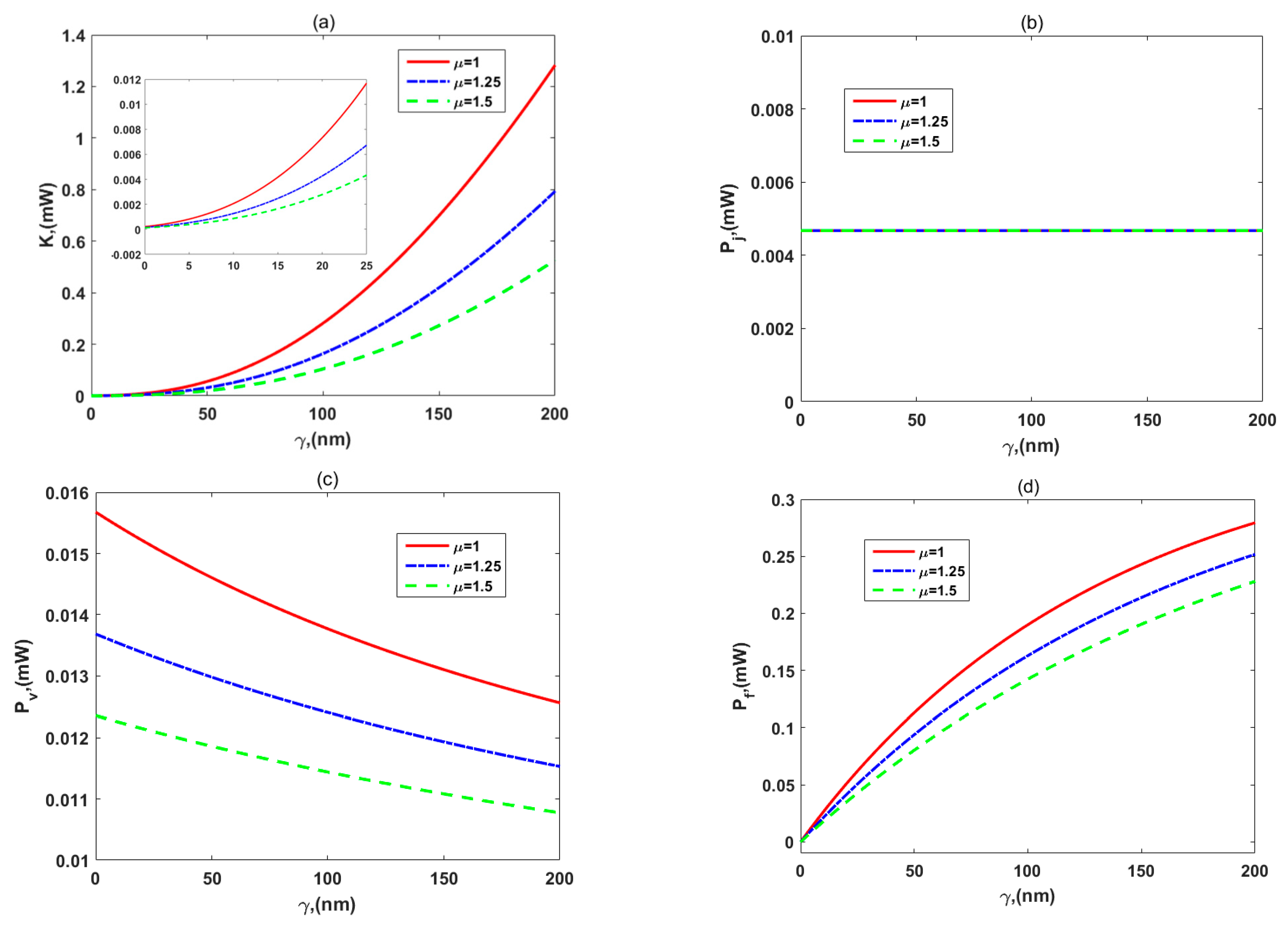
| Design | Parameters | Single Emitter Performances | ||||||||||
|---|---|---|---|---|---|---|---|---|---|---|---|---|
| ε | μ | λFCL/λ | ω (mC/m2) | μc (Pa s/m2) | γ (nm) | d (nm) | ρr | Isp (s) | Th (μN) | ζ (mN/W) | ηt (%) | |
| EOT1 | 0.75 | 1 | 0.5 | −6.5 | 0.0034 | 175 | 10 | 3.5 | 121.4 | 20.84 | 1.53 | 90.40 |
| EOT2 | 0.25 | 1.05 | 1 | −6.5 | 0.09 | 175 | 10 | 3.5 | 70.97 | 6.98 | 2.41 | 82.46 |
Publisher’s Note: MDPI stays neutral with regard to jurisdictional claims in published maps and institutional affiliations. |
© 2021 by the authors. Licensee MDPI, Basel, Switzerland. This article is an open access article distributed under the terms and conditions of the Creative Commons Attribution (CC BY) license (https://creativecommons.org/licenses/by/4.0/).
Share and Cite
Zheng, J.; Jian, Y. Space Electroosmotic Thrusters in Ion Partitioning Soft Nanochannels. Micromachines 2021, 12, 777. https://doi.org/10.3390/mi12070777
Zheng J, Jian Y. Space Electroosmotic Thrusters in Ion Partitioning Soft Nanochannels. Micromachines. 2021; 12(7):777. https://doi.org/10.3390/mi12070777
Chicago/Turabian StyleZheng, Jiaxuan, and Yongjun Jian. 2021. "Space Electroosmotic Thrusters in Ion Partitioning Soft Nanochannels" Micromachines 12, no. 7: 777. https://doi.org/10.3390/mi12070777
APA StyleZheng, J., & Jian, Y. (2021). Space Electroosmotic Thrusters in Ion Partitioning Soft Nanochannels. Micromachines, 12(7), 777. https://doi.org/10.3390/mi12070777






